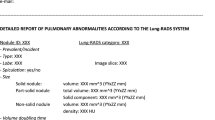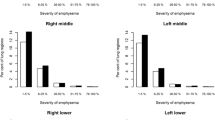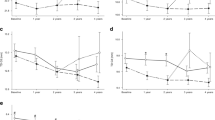Abstract
Objective
To longitudinally evaluate effects of smoking cessation on quantitative CT in a lung cancer screening cohort of heavy smokers over 4 years.
Methods
After 4 years, low-dose chest CT was available for 314 long-term ex-smokers (ES), 404 continuous smokers (CS) and 39 recent quitters (RQ) who quitted smoking within 2 years after baseline CT. CT acquired at baseline and after 3 and 4 years was subjected to well-evaluated densitometry software, computing mean lung density (MLD) and 15th percentile of the lung density histogram (15TH).
Results
At baseline, active smokers showed significantly higher MLD and 15TH (-822±35 and -936±25 HU, respectively) compared to ES (-831±31 and -947±22 HU, p<0.01–0.001). After 3 years, CS again had significantly higher MLD and 15TH (-801±29 and -896±23 HU) than ES (-808±27 and -906±20 HU, p<0.01–0.001) but also RQ (-813±20 and -909±15 HU, p<0.05-0.001). Quantitative CT parameters did not change significantly after 4 years. Importantly, smoking status independently predicted MLD at baseline and year 3 (p<0.001) in multivariate analysis.
Conclusion
On quantitative CT, lung density is higher in active smokers than ex-smokers, and sustainably decreases after smoking cessation, reflecting smoking-induced inflammation. Interpretations of quantitative CT data within clinical trials should consider smoking status.
Key Points
• Lung density is higher in active smokers than ex-smokers.
• Lung density sustainably decreases after smoking cessation.
• Impact of smoking cessation on lung density is independent of potentially confounding factors.
• Smoke-induced pulmonary inflammation and particle deposition influence lung density on CT.

Similar content being viewed by others
Abbreviations
- 15TH:
-
15th percentile of lung density histogram
- ATS:
-
American Thoracic Society
- BMI:
-
Body mass index
- COPACETIC COPD Pathology:
-
Addressing Critical Gaps, Early Treatment and Diagnosis and Innovative Concepts.
- COPD:
-
Chronic obstructive pulmonary disease
- CS:
-
Continuous smokers
- CT:
-
Multidetector computed tomography
- DFG:
-
German Research Council
- ECSC:
-
European Coal and Steal Community
- EI:
-
Emphysema index
- ES:
-
Ex-smokers
- EV:
-
Emphysema volume
- FEV1%:
-
Forced expiratory volume in 1 s in percent predicted
- FEV1/FVC:
-
Tiffenau index
- FEV1:
-
Forced expiratory volume in 1 s
- FVC:
-
Forced vital capacity
- GOLD:
-
Global Initiative for Chronic Obstructive Lung Disease
- HU:
-
Hounsfield units
- LAA%950 :
-
Percentage of low attenuation areas at a threshold of -950 HU
- LUSI:
-
Lung Cancer Screening Intervention Trial
- LV:
-
Lung volume
- MLD:
-
Mean lung density
- PD15:
-
15th percentile of lung density histogram
- PFT:
-
Pulmonary function testing
- QCT:
-
Quantitative CT
- RB-ILD:
-
Respiratory bronchiolitis interstitial lung disease
- RQ:
-
Recent quitters
- YACTA:
-
Yet Another CT Analyzer
References
Coxson HO, Mayo J, Lam S, Santyr G, Parraga G, Sin DD (2009) New and current clinical imaging techniques to study chronic obstructive pulmonary disease. Am J Respir Crit Care Med 180:588–597
Rabe KF, Hurd S, Anzueto A et al (2007) Global strategy for the diagnosis, management, and prevention of chronic obstructive pulmonary disease: GOLD executive summary. Am J Respir Crit Care Med 176:532–555
Lynch DA, Austin JH, Hogg JC et al (2015) CT-definable subtypes of chronic obstructive pulmonary disease: a statement of the Fleischner Society. Radiology. doi:https://doi.org/10.1148/radiol.2015141579:141579
Coxson HO, Rogers RM (2005) Quantitative computed tomography of chronic obstructive pulmonary disease. Acad Radiol 12:1457–1463
Kauczor HU, Wielputz MO, Owsijewitsch M, Ley-Zaporozhan J (2011) Computed tomographic imaging of the airways in COPD and asthma. Journal of thoracic imaging 26:290–300
Ley-Zaporozhan J, van Beek EJ (2010) Imaging phenotypes of chronic obstructive pulmonary disease. Journal of magnetic resonance imaging : JMRI 32:1340–1352
Heussel CP, Herth FJ, Kappes J et al (2009) Fully automatic quantitative assessment of emphysema in computed tomography: comparison with pulmonary function testing and normal values. Eur Radiol 19:2391–2402
Hoffman EA, Simon BA, McLennan G (2006) State of the Art. A structural and functional assessment of the lung via multidetector-row computed tomography: phenotyping chronic obstructive pulmonary disease. Proc Am Thorac Soc 3:519–532
Coxson HO, Dirksen A, Edwards LD et al (2013) The presence and progression of emphysema in COPD as determined by CT scanning and biomarker expression: a prospective analysis from the ECLIPSE study. The Lancet Respiratory medicine 1:129–136
Gevenois PA, De Vuyst P, de Maertelaer V et al (1996) Comparison of computed density and microscopic morphometry in pulmonary emphysema. Am J Respir Crit Care Med 154:187–192
Coxson HO, Rogers RM, Whittall KP et al (1999) A quantification of the lung surface area in emphysema using computed tomography. Am J Respir Crit Care Med 159:851–856
Regan EA, Hokanson JE, Murphy JR et al (2010) Genetic epidemiology of COPD (COPDGene) study design. COPD 7:32–43
Han MK, Kazerooni EA, Lynch DA et al (2011) Chronic obstructive pulmonary disease exacerbations in the COPDGene study: associated radiologic phenotypes. Radiology 261:274–282
Sciurba FC, Ernst A, Herth FJ et al (2010) A randomized study of endobronchial valves for advanced emphysema. N Engl J Med 363:1233–1244
Grydeland TB, Dirksen A, Coxson HO et al (2009) Quantitative computed tomography: emphysema and airway wall thickness by sex, age and smoking. The European respiratory journal 34:858–865
Camiciottoli G, Cavigli E, Grassi L et al (2009) Prevalence and correlates of pulmonary emphysema in smokers and former smokers. A densitometric study of participants in the ITALUNG trial. Eur Radiol 19:58–66
Mohamed Hoesein FA, Zanen P, de Jong PA et al (2013) Rate of progression of CT-quantified emphysema in male current and ex-smokers: a follow-up study. Respiratory research 14:55
Zach JA, Williams A, Jou SS et al (2016) Current Smoking Status Is Associated With Lower Quantitative CT Measures of Emphysema and Gas Trapping. Journal of thoracic imaging 31:29–36
Shaker SB, Stavngaard T, Laursen LC, Stoel BC, Dirksen A (2011) Rapid fall in lung density following smoking cessation in COPD. COPD 8:2–7
Ashraf H, Lo P, Shaker SB et al (2011) Short-term effect of changes in smoking behaviour on emphysema quantification by CT. Thorax 66:55–60
Becker N, Motsch E, Gross ML et al (2012) Randomized study on early detection of lung cancer with MSCT in Germany: study design and results of the first screening round. J Cancer Res Clin Oncol 138:1475–1486
Becker N, Motsch E, Gross ML et al (2015) Randomized Study on Early Detection of Lung Cancer with MSCT in Germany: Results of the First 3 Years of Follow-up After Randomization. Journal of thoracic oncology : official publication of the International Association for the Study of Lung Cancer 10:890–896
Bade M, Bahr V, Brandt U et al (2016) Effect of smoking cessation counseling within a randomised study on early detection of lung cancer in Germany. J Cancer Res Clin Oncol 142:959–968
Miller MR, Hankinson J, Brusasco V et al (2005) Standardisation of spirometry. The European respiratory journal 26:319–338
Quanjer PH, Tammeling GJ, Cotes JE, Pedersen OF, Peslin R, Yernault JC (1993) Lung volumes and forced ventilatory flows. Report Working Party Standardization of Lung Function Tests, European Community for Steel and Coal. Official Statement of the European Respiratory Society. Eur Respir J Suppl 16:5–40
Weinheimer O, Achenbach T, Heussel CP, Düber C (2011) Automatic Lung Segmentation in MDCT Images Fourth International Workshop on Pulmonary Image Analysis 2011, pp 241-255
Wielputz MO, Weinheimer O, Eichinger M et al (2013) Pulmonary emphysema in cystic fibrosis detected by densitometry on chest multidetector computed tomography. PLoS One 8:e73142
Wielputz MO, Bardarova D, Weinheimer O et al (2014) Variation of densitometry on computed tomography in COPD--influence of different software tools. PloS one 9:e112898
Heussel CP, Kappes J, Hantusch R et al (2009) Contrast enhanced CT-scans are not comparable to non-enhanced scans in emphysema quantification. Eur J Radiol 74:473–478
Wielputz MO, Eichinger M, Weinheimer O et al (2013) Automatic airway analysis on multidetector computed tomography in cystic fibrosis: correlation with pulmonary function testing. Journal of thoracic imaging 28:104–113
Lim HJ, Weinheimer O, Wielputz MO et al (2016) Fully Automated Pulmonary Lobar Segmentation: Influence of Different Prototype Software Programs onto Quantitative Evaluation of Chronic Obstructive Lung Disease. PLoS One 11:e0151498
Holm S (1979) A simple sequentially rejective multiple test procedure. Scandinavian Journal of Statistics 6:65–70
Zaporozhan J, Ley S, Weinheimer O et al (2006) Multi-detector CT of the chest: influence of dose onto quantitative evaluation of severe emphysema: a simulation study. Journal of computer assisted tomography 30:460–468
Yuan R, Mayo JR, Hogg JC et al (2007) The effects of radiation dose and CT manufacturer on measurements of lung densitometry. Chest 132:617–623
Gierada DS, Bierhals AJ, Choong CK et al (2010) Effects of CT section thickness and reconstruction kernel on emphysema quantification relationship to the magnitude of the CT emphysema index. Acad Radiol 17:146–156
Smith BM, Barr RG (2013) Establishing normal reference values in quantitative computed tomography of emphysema. Journal of thoracic imaging 28:280–283
Gietema HA, Schilham AM, van Ginneken B, van Klaveren RJ, Lammers JW, Prokop M (2007) Monitoring of smoking-induced emphysema with CT in a lung cancer screening setting: detection of real increase in extent of emphysema. Radiology 244:890–897
Soejima K, Yamaguchi K, Kohda E et al (2000) Longitudinal follow-up study of smoking-induced lung density changes by high-resolution computed tomography. Am J Respir Crit Care Med 161:1264–1273
Kauczor HU, Heussel CP, Herth FJ (2013) Longitudinal quantitative low-dose CT in COPD: ready for use? The Lancet Respiratory medicine 1:95–96
Sieren JP, Newell JD, Judy PF et al (2012) Reference standard and statistical model for intersite and temporal comparisons of CT attenuation in a multicenter quantitative lung study. Medical physics 39:5757–5767
Stoel BC, Putter H, Bakker ME et al (2008) Volume correction in computed tomography densitometry for follow-up studies on pulmonary emphysema. Proc Am Thorac Soc 5:919–924
Madani A, Van Muylem A, Gevenois PA (2010) Pulmonary emphysema: effect of lung volume on objective quantification at thin-section CT. Radiology 257:260–268
Acknowledgements
We thank all participants for their willingness to contribute to this study. The expert technical assistance of Julia Schliebus and Martina Jochim are gratefully appreciated. This work contains parts of the doctoral thesis of Mila Trauth, Heidelberg, Germany.
Funding
This study has received funding by the Dietmar Hopp Foundation (2007–2010) and the German Research Association (DFG) (2007–2013). The COPACETIC study was funded by EU FP7 grant 201379.
Author information
Authors and Affiliations
Corresponding author
Ethics declarations
Guarantor
The scientific guarantor of this publication is Mark O. Wielpütz.
Conflict of interest
The authors of this manuscript declare no relationships with any companies whose products or services may be related to the subject matter of the article.
Statistics and biometry
One of the authors has significant statistical expertise.
Ethical approval
Institutional Review Board approval was obtained (approved by the Ethics Committee of the Medical Faculty of the University of Heidelberg (073/2001) and the federal radiation protection authority (22462/2 2006-045)).
Informed consent
Written informed consent was obtained from all subjects (patients) in this study.
Study subjects or cohorts overlap
The study subjects have been previously reported in J Thorac Oncol. 2015 Jun;10(6):890-6, Am J Respir Crit Care Med. 2015 Mar 1;191(5):547-56, J Cancer Res Clin Oncol. 2012 Sep;138(9):1475-86, and Eur J Radiol. 2014 Mar;83(3):600-5, investigating data or aspects that were significantly different from the present study.
Methodology
• prospective
• randomised controlled trial
• observational
• performed at one institution
Rights and permissions
About this article
Cite this article
Jobst, B.J., Weinheimer, O., Trauth, M. et al. Effect of smoking cessation on quantitative computed tomography in smokers at risk in a lung cancer screening population. Eur Radiol 28, 807–815 (2018). https://doi.org/10.1007/s00330-017-5030-6
Received:
Revised:
Accepted:
Published:
Issue Date:
DOI: https://doi.org/10.1007/s00330-017-5030-6




